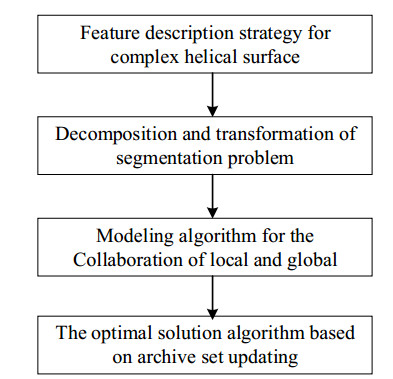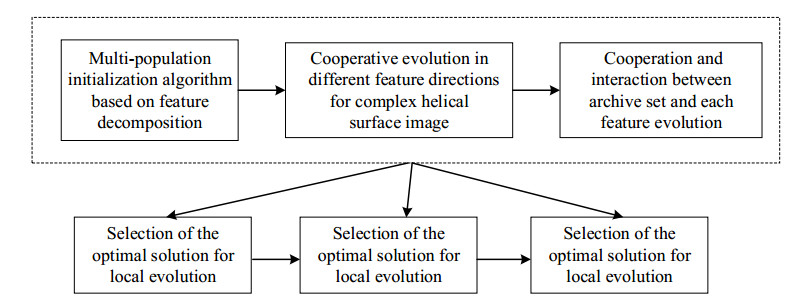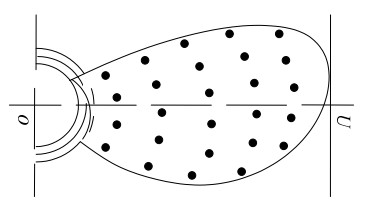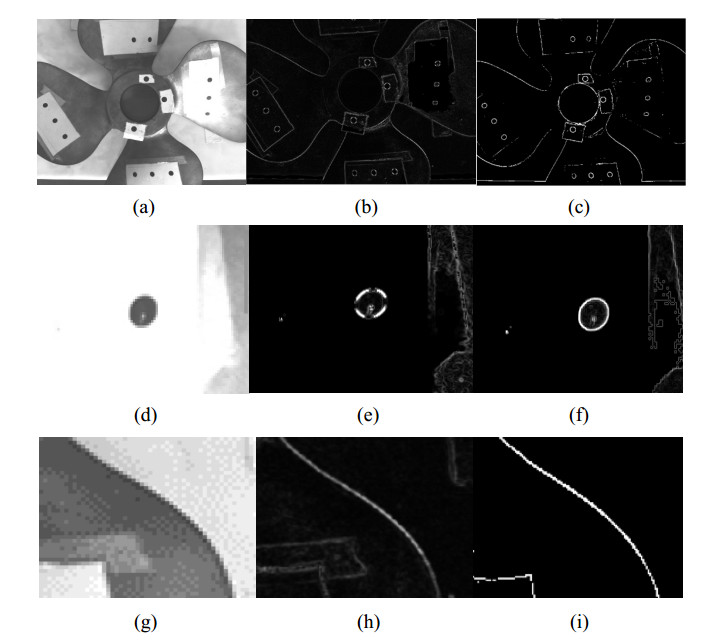Accurate image segmentation results would show a great significance to computer vision-based manufacturing for complex helical surface. However, the image segmentation for complex helical surface is always a difficult problem because of the uneven gray distribution and non-homogeneous feature patterns of its images. Therefore, a multi-direction evolutionary segmentation model is constructed and a multi-population cooperative evolution algorithm is proposed to solve the new model. According to the characteristics of gray distribution and feature patterns of complex helical surface image, an eigenvector extraction and description strategy is researched by combining gray level co-occurrence matrix algorithm with fractal algorithm, and the complex helical surface image can be described succinctly by gray feature and shape feature. Based on the description algorithm of image features, an image segmentation strategy using cooperative evolution from different eigenvector is discussed, and the helical surface image segmentation is decomposed from a single objective optimization problem to a multi-objective optimization problem to improve the accuracy of segmentation. Meanwhile, a multi-objective particle swarm optimization algorithm based on multi-directional evolution and shared archives is presented. Due to the fact that each eigenvector segmentation corresponds to one evolution direction, the collaboration of local and global segmentation can be realized by information sharing and interaction between evolution directions and the archive set. The comprehensive quality of non-dominated solution can be improved by the selection strategy of local and global optimal solution as well as the archive set maintenance. The practical numerical experiments for complex helical surface image segmentation are carried out to prove the validity of the proposed model and algorithm.
1.
Introduction
Allergic rhinitis (AR) is defined by an inflammatory response triggered by allergens, presenting with characteristic nasal symptoms such as itching, rhinorrhea, nasal obstruction, and sneezing. This condition affects approximately 25% of children and 40% of adults worldwide, causing significant impairment to patients' quality of life and posing a considerable societal burden [1].
The sensitization patterns of allergens in AR exhibit global variations, influenced by a range of geographical, climatic, cultural, and genetic factors [2]. Worldwide, house dust mites (HDMs) and grass pollen are consistently identified as the most prevalent inhalant allergens [3,4,5]. However, despite numerous studies exploring allergen sensitization in China, most of them have focused primarily on specific geographical regions and the Han ethnic group [6,7,8]. In 2009, a study aimed to assess the frequency of common aeroallergens among allergic asthma and/or rhinitis across China reported an overall positive skin prick response rate of 59.0% for Dermatophagoides farinae and 57.6% for Dermatophagoides pteronyssinus [9].
In this study, we aim to compare the types of allergens in children from two different provinces in China with different ethnic groups, in an attempt to analyze the effects of environmental and genetic factors on allergen types.
2.
Methods
2.1. Patients
From January 2019 to December 2023, children presenting with typical nasal symptoms such as rhinorrhea, nasal obstruction, itching, and sneezing were recruited for the study in accordance with the ARIA guidelines at our hospital [1]. All children recruited from Guangzhou are Han nationality, and all children recruited from Liuzhou are Zhuang nationality. Utilizing the ImmunoCAP 100 system (Thermo Fisher), the specific IgE response to a comprehensive panel of foods and inhalant allergens pertinent to the Chinese diet was evaluated. The inhalant allergens tested included Dermatophagoides farinae, Dermatophagoides pteronyssinus, German cockroach, cat dander, dog dander, common ragweed, and mugwort. A serum-specific IgE (sIgE) level of ≥0.35 kUA/L was considered positive for allergen sensitization. Exclusion criteria for the study were as follows: Children with negative allergen screening results; children had undergone systemic steroid or biological treatment or malignancy therapy; children with nasal polyps or chronic sinusitis; and children diagnosed with severe autoimmune diseases, parasitic infections, or cancer. The protocol was approved by the local Ethics Committee Guangzhou Medical University.
2.2. Statistical analysis
Statistical analysis was conducted using the SPSS 20 software package. The data were summarized using the median, discrete numbers, and ratios to provide a comprehensive overview. For comparisons, the Chi-square test or Fisher's exact test was employed, depending on the nature of the data and the assumptions of each test. A statistically significant result was defined as a P-value lower than 0.05, indicating a meaningful difference between the groups or variables being compared.
3.
Results
3.1. Comparison of study populations between Guangzhou and Liuzhou AR children
A total of 9684 and 1679 AR children from Guangzhou and Liuzhou were recruited. As shown in Table 1, the age, sex ratio, mono-sensitized ratio, poly-sensitized ratio, and disease duration showed no significant differences between the two groups (P > 0.05).
3.2. Overall prevalence of aeroallergen sensitization of children in Guangzhou and Liuzhou
The sensitization rates to D. farinae, D. pteronyssinus, cat dander, dog dander, common ragweed, and mugwort in Guangzhou were significantly higher than those in Liuzhou (Table 2). The sensitization rates to cockroaches showed no significant differences between the two cities (Table 2).
3.3. Aeroallergen sensitization by age groups
The sensitization rates to D. farina in Guangzhou were significantly higher than those in Liuzhou of all three age groups (Table 3). In preschool children (1–6 years old), the positive rates of sensitization to cockroaches, dog dander, common ragweed, and mugwort were significantly different between Guangzhou and Liuzhou, while the positive rates of sensitization to D. pteronyssinus and cat dander showed no significant differences between the two cities (Table 3).
In the school-age group (7–12 years old), the positive rates of sensitization to D. farina, D. pteronyssinus, cat dander, dog dander, and mugwort were significantly different between Guangzhou and Liuzhou, while the positive rates of sensitization to cockroaches, cat dander, and common ragweed showed no significant differences (Table 3).
In the 13–18 years old group, the positive rates of sensitization to D. farina, cockroaches, and cat dander were significantly different between Guangzhou and Liuzhou, while the positive rates of sensitization to other allergens showed no significant differences between the two cities (Table 3).
3.4. Aeroallergen sensitization by gender
As shown in Table 4, the positive rates of sensitization to all allergens except for cockroaches were higher in Guangzhou boys compared with Liuzhou boys (Table 4). The positive rates of sensitization to all allergens except for cockroaches and common ragweed were higher in Guangzhou girls compared with Liuzhou girls (Table 4). The positive rates of sensitization to all allergens showed no significant differences between Guangzhou boys and girls. Similarly, the positive rates of sensitization to all allergens also showed no significant differences between Liuzhou boys and girls (Table 4).
3.5. Aeroallergen sensitization among seasons
In spring, the positive rates of sensitization to D. farina, D. pteronyssinus, and cockroaches were significantly different between Guangzhou and Liuzhou (Table 5). In summer, the positive rates of sensitization to D. farina, cat dander, dog dander, and mugwort were significantly different between Guangzhou and Liuzhou (Table 5). In autumn, the positive rates of sensitization to D. farina, cat dander, common ragweed, and mugwort were significantly different between Guangzhou and Liuzhou (Table 5). In winter, only the positive rate of sensitization to D. farina was significantly different between Guangzhou and Liuzhou (Table 5).
The positive rates of sensitization to all allergens in Guangzhou were not significantly different between different seasons. Similarly, the positive rates of sensitization to all allergens in Liuzhou showed no significant differences between different seasons.
3.6. Aeroallergen sensitization by disease duration and living environment
The positive rates of sensitization to all allergens showed no significant differences when grouped according to disease duration and living environment (Tables 6 and 7).
4.
Discussion
Atopic sensitization is a significant risk factor for the development of both upper and lower respiratory symptoms [10]. Given its pivotal role in the onset and progression of allergic conditions, allergen avoidance is a crucial aspect of treating allergic rhinitis. By identifying and avoiding allergens as early as possible, individuals can potentially slow down the development and severity of allergic rhinitis, thereby improving their overall quality of life and reducing the need for more aggressive treatment options.
China, a vast country with a rapidly developing economy, diverse geography, climate, and ethnicities, exhibits significant regional variations in the distribution of allergens. Previous reports have revealed the prevalence and patterns of allergen sensitization in different regions of China. For instance, Li et al. conducted a survey in 2009 among 6,304 patients with asthma and/or rhinitis across 17 cities in four regions of China [9]. They found that Dermatophagoides farina and Dermatophagoides pteronyssinus were the most common aeroallergens among patients with perennial/persistent allergic rhinitis. Notably, the highest prevalence of sensitization to house dust mites was observed in the southwestern region of China. Another hospital-based survey in southern China reported that sensitization to house dust mites (D. pteronyssinus, D. farinae, and B. tropicalis) was the most common, followed by sensitization to other allergens such as dog dander, cockroaches, mold mix, and various pollens [11]. More recently, Sun's team reported on the overall prevalence of positive sIgE responses to nine common allergens across China [12]. Their findings indicated that the highest prevalence was for sensitization to house dust mites, followed by cockroaches, tree pollen mix, dog dander, and mold mix.
In this study, we compared two cities in southern China, Guangzhou in the Guangdong Province and Liuzhou in the Guangxi Province. Guangzhou and Liuzhou are located at similar latitudes, with similar annual average temperatures (22 ℃ vs. 21 ℃), humidity (78% vs. 79%), and rainfall (1830.2 mm vs. 1841.5 mm). We hope to compare the types of allergens in children from two nationalities with similar climate conditions to preliminarily analyze the impact of racial factors on allergens. Our results show that children with allergic rhinitis in two cities are mainly allergic to mites, but the sensitization rates of two types of mites in Guangzhou are higher than those in Liuzhou. This may be related to the slightly higher average temperature in Guangzhou compared to Liuzhou, which is more suitable for mite growth (22 ℃ vs. 21 ℃). Allergies to cat and dog dander also show a higher trend in Guangzhou than in Liuzhou, which may be related to the higher pet ownership in Guangzhou, which was, however, not collected in this study. Therefore, future studies on the correlation between allergy and pet ownership are needed. The sensitization rates of ragweed and mugwort in Guangzhou are also higher than those in Liuzhou, while there is no significant difference in the sensitization rates of cockroaches between the two. Besides the reasons mentioned above, we believe that the following may also potentially explain the difference in sensitization rates between the two regions: The urbanization level, air pollution (especially particulate matter and ozone levels), lifestyle and habits (such as housing conditions, e.g., apartment versus detached houses and ventilation systems), dietary habits (including the consumption of allergenic foods), hygiene practices that may affect the microbial environment and immune system development, and socioeconomic status.
Boulet proposed that sensitization to all allergens intensifies and peaks during young adulthood [13]. Wu's study found that individuals in the 7–14 year age bracket demonstrated heightened reactivity to tested airborne allergens compared to those aged 0–6 years [14]. A longitudinal study in an urban Italian population center noted an 11.6% increase in the positive rate of skin prick tests over a 6–10 year observation period [15]. We observed age-related allergen sensitization disparities between Guangzhou and Liuzhou. In Guangzhou, sensitization to dust mites, mugwort, dog/cat hair, and ragweed was generally higher across all ages, with increasing trends in Liuzhou for dog/cat hair. Cockroach sensitization varied; it was lower in 1–6-year-olds but higher in 13–18-year-olds in Guangzhou vs. Liuzhou, also rising with age in Guangzhou.
The positive rates of sensitization to all allergens (except for cockroaches) were higher in Guangzhou boys compared with Liuzhou boys. However, we did not find differences in sensitization rate between Guangzhou boys and girls. Arbes et al. documented a similar trend, observing a greater likelihood of positive allergen test responses among men [16]. Additionally, a cross-sectional study conducted in China, encompassing 6,304 asthma and/or rhinitis patients, identified male gender as a contributory risk factor for allergen sensitization [17].
Seasonally, dust mites showed minimal variation, higher in Guangzhou year-round except for house dust mites in spring. Cockroaches sensitized more during spring in Liuzhou. Guangzhou children had a higher sensitization to cat/dog hair, ragweed, and mugwort in summer/autumn. However, we did not find a correlation between sensitization and disease duration or living environment.
In sum, in this study, we compared the allergen types of AR children in two cities in southern China with very similar climatic conditions. Overall, the composition of AR allergens in children is similar between the two cities, with house dust mites and dust mites as the main allergens. However, the sensitization rates of all allergens, except for cockroaches, are higher in Guangzhou than those in Liuzhou. Our results suggest that the causes of allergen sensitization are complex, and genetic and environmental factors cannot be ignored. Identifying specific allergens in the local region can guide families to adopt measures such as regular cleaning, using allergen-proof covers for bedding, minimizing outdoor activities during peak pollen seasons, and using preventive medication before the pollen seasons.
Our study also had limitations. In the future, the collection of longitudinal data could help to determine whether sensitization patterns change over time and how they correlate with disease progression. Moreover, exploring the impact of environmental interventions on sensitization rates or genetic predispositions would be helpful for understanding the mechanism of sensitization.
Use of AI tools declaration
The authors declare they have not used Artificial Intelligence (AI) tools in the creation of this article.
Acknowledgments
This study was supported by grants from the National Natural Science Grant of China (No.82271142), Guangdong Special Support Plan for Top Young Talents, Guangdong Province Natural Science Grant (No.2024A1515012386), Guangxi Natural Science Foundation (2024GXNSFBA010264).
Conflict of interest
The authors declare that they have no relevant conflicts of interest.









 DownLoad:
DownLoad:








